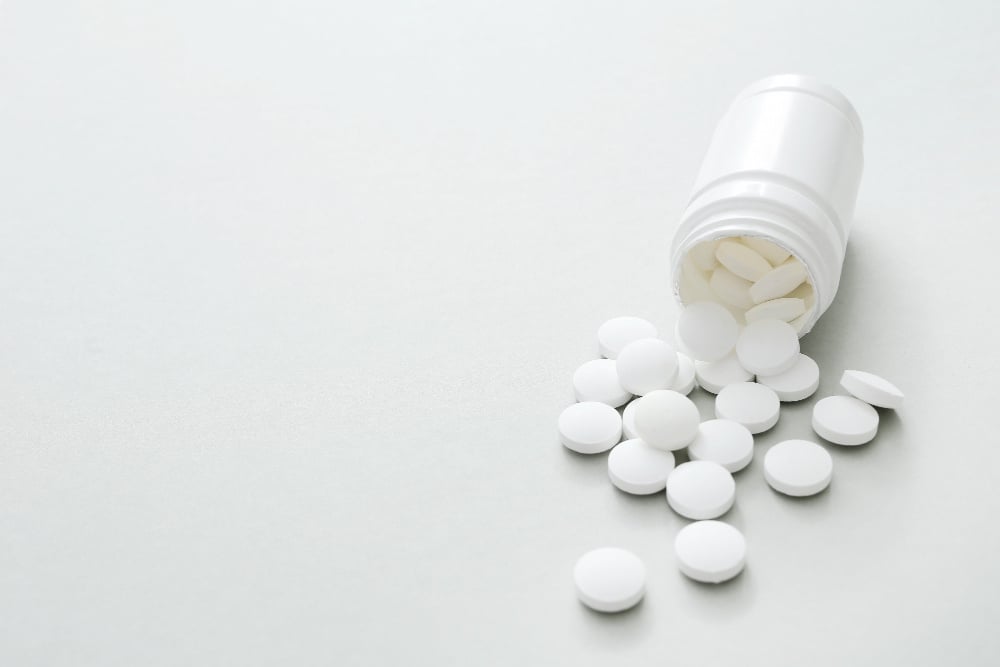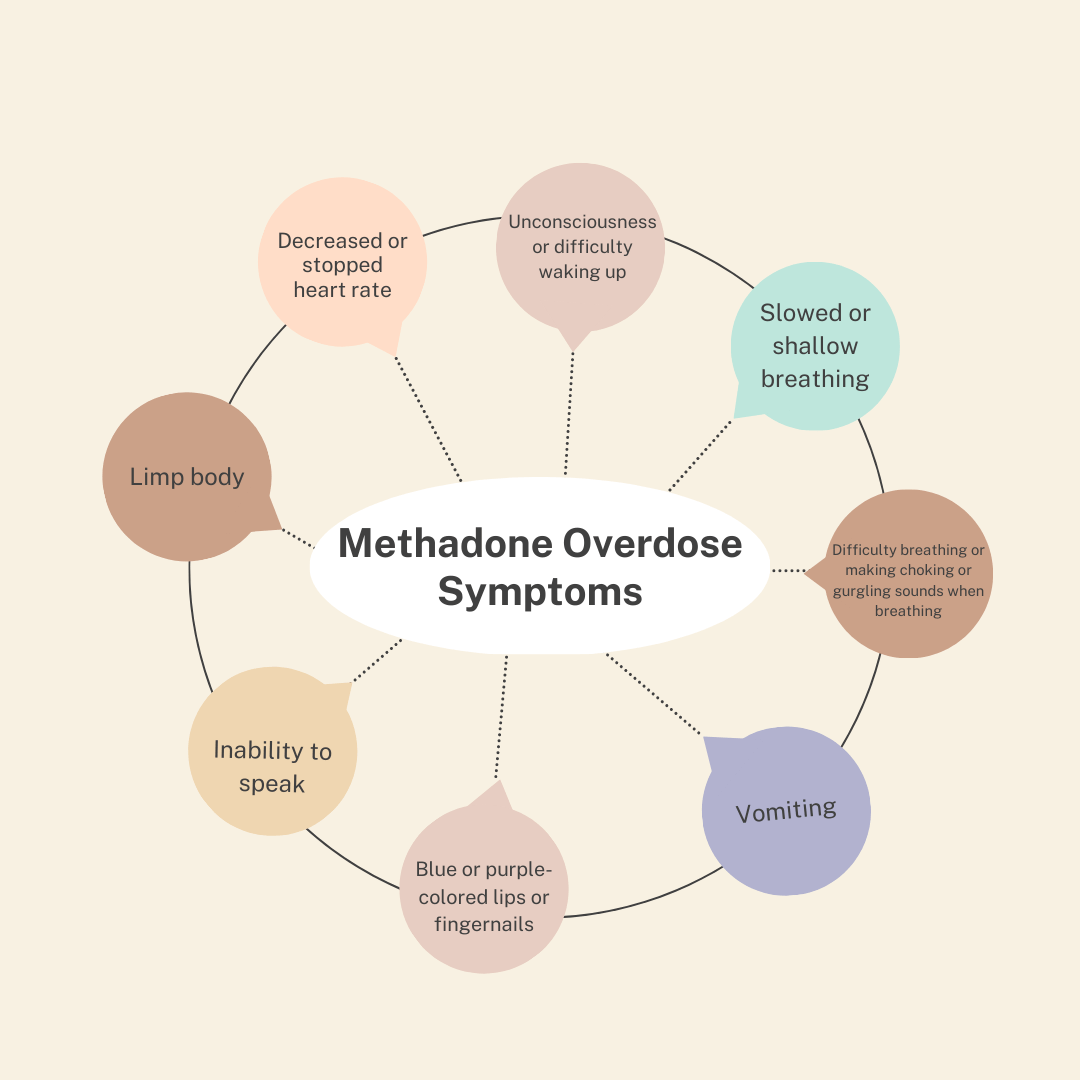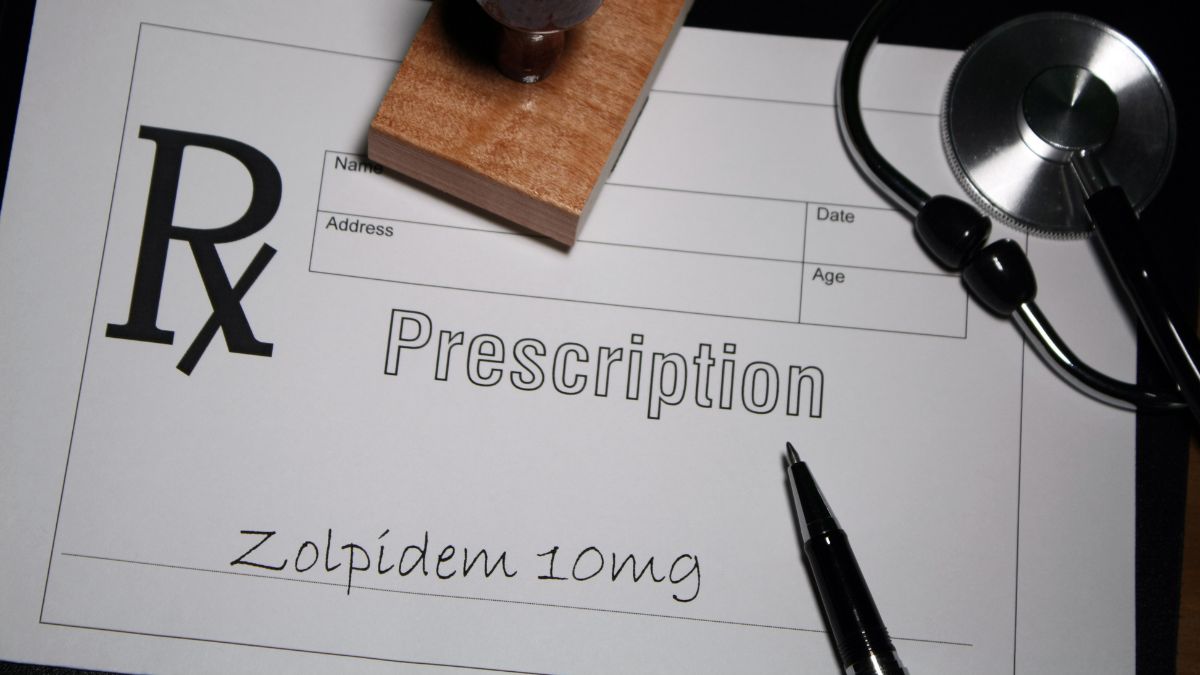Methadone, commonly sold under the brand names Methadose and Dolophine, is a synthetic opioid agonist medication used to treat chronic pain and opioid dependence. If you take methadone long-term, you are more likely to experience side effects. Being aware of the side effects of methadone is a good first line of defense in treatment.
This article discusses the side effects of methadone, its drug interaction, and safety precautions.
What is Methadone?
Methadone is part of a class of drugs referred to as opioids or prescription painkillers. Methadone hydrochloride tablets, which German doctors invented during World War II, were originally used to treat severe pain. Today, the medication is often prescribed as part of a treatment regimen for opioid addiction, particularly heroin.

How is Methadone Taken?
For pain management, patients are usually advised to take methadone every 12 hours. An initial 20 to 30 mg dose is generally administered for addiction management. According to most medication guides, the dosage of methadone depends on the intensity of an individual’s addiction to the type of opioid medication they are using. The goal is to provide enough dosage to prevent withdrawal symptoms.
If the initial dosage proves insufficient, another 5 or 10 mg dose is often supplied. 40 mg is usually considered the maximum medically allowed dose per day. It is important for individuals struggling with opioid use disorder to be under careful medical supervision when being treated for methadone to ensure proper dosages are applied.
A doctor’s prescription is always required to obtain methadone. Your healthcare provider will supply you with the appropriate dosage for you. They may also alter your dosage during treatment. Notify your physician if you feel any untoward symptoms while using it. Don’t discontinue methadone without consulting a healthcare professional first.
Is Methadone Addictive?
While methadone is used legitimately to opioid addiction treatment, there is always the risk that a user can develop a methadone addiction. Like other opioid medications, methadone is physically and psychologically addictive. Methadone is classified by the Drug Enforcement Administration (DEA) as a Schedule II substance. This indicates that this opiate painkiller has a huge potential for abuse and can cause physical dependence in users.
If methadone therapy is not medically supervised, it can lead to drug abuse and addiction. When a person uses methadone for recreational purposes and develops a physical dependence, tolerance and opioid withdrawal may appear. Tolerance and withdrawal are considered indicators that the person has developed a substance use problem.

Tolerance is a condition requiring higher doses to have the same effect. If tolerance develops, the patient may attempt to alter the dosage or increase the medication frequency. This behavior results in addiction. Meanwhile, opioid withdrawal occurs when an individual suddenly stops using a substance upon which their body has become reliant.
While methadone is normally prescribed in powder, tablet, or liquid form, individuals looking to abuse methadone often inject it for quicker or more intense effects. This method exposes them to other health risks, including hepatitis or HIV.
Physical Side Effects of Methadone
Even when methadone is used briefly, some undesirable side effects may occur. Physical side effects of methadone vary depending on dosage and how long it is used. These side effects range from moderate to severe, including:
- Stomach cramps, dry mouth
- Urinary retention
- Sexual impotence
- Tremors, unstable gait
- Drowsiness, lightheadedness, fainting, seizures
- Anaphylactic reactions
- Irregular heartbeat
- Respiratory depression (slow, shallow breathing)
- Death due to overdose
Call Design for Recovery to Begin Your Healing Journey!
Reach out to our team to discuss sober living options and next steps toward a healthier routine.
Psychological Side Effects of Methadone
In addition to its physical effects, methadone is known to have psychological side effects, including the following symptoms:
- Anxiety
- Depression
- Hallucinations
- Paranoia
- Delusions
- Insomnia
- Impaired concentration
- Suicidal thoughts
Long-Term Effects of Methadone
Chronic opioid use can cause long-term effects that become more serious over time. Slowed breathing can intensify to dangerous levels. Users can experience a feeling of lightheadedness and even faintness. Hives, rash, and swollen lips, tongue, throat, or face can occur if an allergy to methadone is present. Sometimes, users of this pain reliever who take heavy doses experience chest pain or changes in heart rhythm. It is possible to experience confusion bordering on psychosis, sometimes leading to hallucinations.
Nerve, Liver, and Brain Damage
A study conducted in 2011 and published in the journal Pharmacology Biochemistry and Behavior found that chronic methadone use can cause damage to nerves, the liver, and the brain. Although the research was carried out on rats, the researchers believe the findings could also apply to people who take methadone for extended periods.
Reproductive Health and Libido
Methadone’s long-term effects on women include disrupting menstrual cycles. While using methadone, both men and women have reported experiencing a decrease in their sexual desire or sexual performance. The National Institute on Drug Addiction recommends that pregnant women take methadone to treat opioid addiction.
Methadone in the Blood
The long-term effects of methadone in the blood are potentially dangerous. Methadone is harmful, and a buildup can occur if the body cannot metabolize the substance properly. Subsequently, the accumulation could result in a fatal overdose.

Moreover, people with opiate use disorders who combine substances expose themselves to the possibility of complications that may result in organ failure and other long-term health problems. They may include liver damage, hypertensive problems, cardiovascular disease, and brain damage. Additional issues, such as poor dental hygiene and skin problems, can also emerge from self-neglect, poor nutrition, or other harmful practices caused by substance use disorder
Contact Design for Recovery Today!
Fill out our quick form to connect with a peer mentor and learn how our sober living community supports accountability, structure, and personal growth in recovery.
Methadone Use on Pregnant and Breastfeeding Women
Methadone is safe to use by pregnant or breastfeeding women. As mentioned earlier, it is recommended for pregnant women struggling with opioid use disorder. However, prenatal care must be incorporated into any comprehensive methadone maintenance treatment to lower the risk of maternal and infant problems.

If you are pregnant and hooked on heroin or opioids, you must seek treatment to protect yourself and your growing baby. Your doctor will consider your addiction when determining your course of treatment. Taking methadone during pregnancy does not cause birth defects, but it may cause withdrawal in the child. Nonetheless, the majority of mothers using methadone are proven to have fewer health issues than mothers continuously taking heroin or other opioids.
Methadone Use on Older Adults
There are many benefits of methadone treatment for older adults. For instance, methadone tablets may be crushed before administration. Most oral opioids cannot be crushed. When a patient needs a long-acting opioid for pain relief but has difficulty swallowing or is getting medication through a feeding tube, crushing the pills is a beneficial option for administering the medication.

Another aspect is that methadone does not have metabolic by-products requiring renal excretion. This is a significant advantage for elderly persons with decreased renal function.
Methadone Use on People with Medical Problems
Methadone can cause side effects that may exacerbate the symptoms of people with certain medical problems, such as:
Gastrointestinal (GI) obstruction- This medication can cause severe constipation and raises the chance of developing a gastrointestinal obstruction. Doctors must not prescribe methadone for patients with paralytic ileus, a lack of muscular tone in the intestines.
Kidney or Liver Problems– Individuals with kidney or liver problems may have trouble metabolizing this medication effectively. This may increase methadone levels in the body and create further adverse effects.
Heart Problems– Methadone may cause a prolonged QT interval, a rare heart condition that can lead to fainting, irregular heartbeat, or even death.
Breathing Problems– This medication has been known to induce respiratory depression symptoms (slow and shallow breathing). People with breathing problems or severe asthma should consult a healthcare professional to see if this medication is appropriate.
Head Injury– This medication may raise the risk of increased pressure in the brain. In an individual with a brain tumor or head injury, methadone use can also lead to life-threatening respiratory depression.
Seizures– This medication may induce more seizures in people with epilepsy. If seizure control worsens while using this medication, seek medical attention immediately
Allergies and Drug Interactions
Some people can also experience an allergic reaction to methadone. Common symptoms of an allergy to methadone include hives and difficulty breathing. If you experience any of these symptoms, seek immediate medical attention.
Methadone also poses unique risks when combined with other medications. It is common for drug interactions to change or amplify the effects of substances. In the case of methadone mixed with other central nervous system depressants such as muscle relaxants (benzodiazepines), the combination can be life-threatening.

Both substances slow down the central nervous system and can result in difficulty breathing, coma, or even death. Combining methadone with antipsychotics, tricyclic antidepressants, and certain heart medications can also increase the risk of an irregular heart rhythm. If any of these more severe side effects occur, it is important to seek emergency medical help or call your doctor immediately.
Most importantly, methadone use carries a high rate of addiction and dependency — even if it is being used to treat those same problems. As such, it should only be used under a doctor’s or pharmacist’s supervision and only at prescribed doses. As such, it should only be used under a doctor’s or pharmacist’s and only at prescribed doses.
Proper Dose and Usage
Methadone is safe and effective when used as directed. To ensure the safe use of the drug, people should provide their entire medical history to their healthcare providers.
The following tips may be helpful in obtaining the best possible outcomes from methadone treatment:
Methadone use requires extreme caution when driving or operating heavy machinery.
If there is a missed dose of methadone or if it appears that the medication does not reach the desired effect, an additional dose must not be taken.
Never take methadone more than the prescribed amount, and always take it on a regular dosing schedule.
Alcohol should be avoided when using methadone.
If you suspect someone has overdosed on methadone, call 911 immediately.
Methadone Overdose Symptoms
Taking methadone can potentially lead to an overdose. There are several signs and symptoms to watch out for in a possible opioid overdose, including:

If you or someone you know takes opioids, it is essential to bring a naloxone kit. Naloxone is a drug that can temporarily counteract the effects of an opioid overdose until medical assistance arrives.
Using Methadone Safely as Part of a Treatment Program
Methadone can be a valuable part of treatment programs for opioid addiction. It can hamper some of the more adverse effects of other opioids and stymie cravings. It also prevents the euphoric effects that heroin causes. When taken according to a doctor’s orders, methadone can help individuals with heroin and other opioid addictions avoid withdrawal symptoms, making a recovery easier. According to findings from studies on drug addiction, methadone may considerably reduce the mortality rate linked to opiate addiction. In addition, the same research found that taking methadone in a controlled setting, followed by ongoing addiction treatment, reduces the likelihood of experiencing a relapse.
For individuals under careful medical supervision who are also receiving holistic help at an outpatient or in-patient treatment center, methadone can be a powerful supplementary treatment for opioid addiction. After going through these treatment regimens, a recovering individual can hope to be sober for a very long time.

Men can maintain their recovery while living in a safe, organized setting in sober living homes. Residents can also establish friendships through our recovery community and develop a strong sense of community and camaraderie.
Take control of your life and join Design For Recovery sober living homes to help overcome your addiction!
- What is Methadone?
- How is Methadone Taken?
- Is Methadone Addictive?
- Physical Side Effects of Methadone
- Psychological Side Effects of Methadone
- Long-Term Effects of Methadone
- Nerve, Liver, and Brain Damage
- Reproductive Health and Libido
- Methadone in the Blood
- Methadone Use on Pregnant and Breastfeeding Women
- Methadone Use on Older Adults
- Methadone Use on People with Medical Problems
- Allergies and Drug Interactions
- Proper Dose and Usage
- Methadone Overdose Symptoms
- Using Methadone Safely as Part of a Treatment Program
Begin Lasting Sobriety Now!
Frequently Asked Questions
Yes. However, its euphoric effects are somewhat least potent than heroin. To experience the “high,” a larger and more frequent dose is required. This is highly dangerous and can lead to overdose or even death. People high on methadone have a slowed thought process, droopy eyelids, dry mouth, and weak muscles.
Yes, people can overdose on methadone. In fact, all opioids carry an overdose risk. The overdose risk is notably high when starting therapy and when resuming opioid use after stopping for a while. Also, combining other substances with opioids raises the likelihood of an overdose.
The best approach to avoid methadone overdose is to take it directly as prescribed by your medical provider. If symptoms of an overdose occur, a friend or a family member must provide the first dose of naloxone, dial 911 immediately, and stay beside the patient to monitor until medical assistance arrives. Naloxone helps counteract the effects of methadone, specifically in restoring normal respiratory function.
Using methadone with other CNS depressants can be extremely hazardous. Avoid using other opioids, alcohol, and benzodiazepines (such as Valium, Ativan, or Xanax). Combining methadone with these substances can further the depressant effect on the nervous system, leading to trouble breathing, systemic hypotension, coma, and even death.
The safest technique to get off methadone is to collaborate with your attending physician on a tapering regimen that gradually lowers your methadone dose. Tapering minimizes withdrawal symptoms and helps avoid relapse. Individuals with opioid use disorder or alcohol abuse, they may engage in a formal narcotic abuse or alcohol rehabilitation program and other recovery options, such as sober living homes.
Medical News Today. (n.d.) Possible Harmful Effects From Prolonged Use Of Methadone. Retrieved on March 21, 2023, from https://www.medicalnewstoday.com/releases/220086#1.
NIDA. (2017, July 1). Treating Opioid Use Disorder During Pregnancy. Retrieved from https://nida.nih.gov/publications/treating-opioid-use-disorder-during-pregnancy.
Substance Abuse and Mental Health Services Administration. (2023, January 25). Methadone. https://www.samhsa.gov/medications-substance-use-disorders/medications-counseling-related-conditions/methadone#:~:text=Methadone%20is%20a%20medication%20used,through%20a%20SAMHSA%20certified%20OTP.
Clinical Guidelines for Withdrawal Management and Treatment of Drug Dependence in Closed Settings. Geneva: World Health Organization; 2009. 6, Methadone maintenance treatment. Available from: https://www.ncbi.nlm.nih.gov/books/NBK310658/







Written By
David Beasley